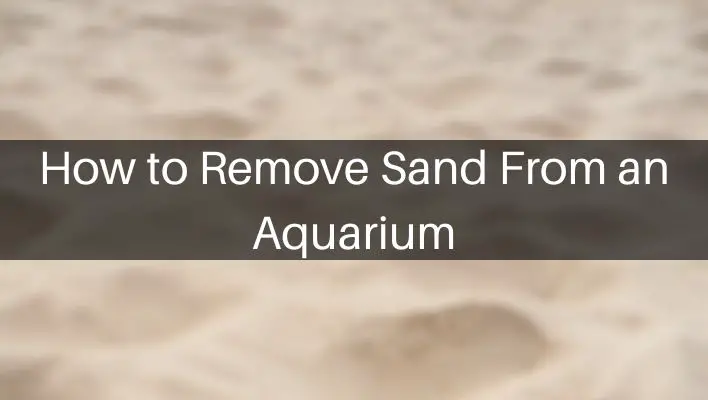
Removing sand from an aquarium can be difficult if you don’t know what you’re doing. However, with the correct method, it can be done quickly and easily.
In this article, we will discuss how to remove sand from an aquarium; safely and effectively!
With the right tools, you can easily remove unwanted sand from your aquarium and protect the health of your fish and other aquatic life.

Removing Sand from an Aquarium
To remove sand from an aquarium, follow these steps:
Step 1: Removing Fish and Other Aquatic Creatures
First, you should transfer fish, plants, and other aquatic creatures to a temporary holding tank or bucket.
Can I remove sand from an aquarium without taking fish out?
Removing sand from an aquarium without taking fish out is not recommended.
The process of removing the sand can create clouds of debris and sediment that can be harmful to fish, as well as upset the water chemistry of the aquarium. The stress of the cleaning process can also harm the fish.
If you still want to remove the sand without taking the fish out, consider using a sand-sifting tool or vacuum that will remove the sand without disturbing the water too much.
However, even with these tools, it is still advisable to take the fish out or at least move them to a separate tank during the cleaning process.
Removing fish from the aquarium before removing sand is essential for the following reasons:
- Stress: The process of removing sand can cause a significant disturbance to the aquarium environment, which can stress the fish and make them more vulnerable to disease and other health issues.
- Water Quality: The process of removing sand can cause clouds of debris and sediment that can harm fish by decreasing water quality and making it difficult for them to breathe.
- Physical Harm: The tools used to remove sand, such as a vacuum or bucket, can cause physical harm to fish if they get too close.
By transferring the fish to a temporary holding tank, you can ensure their safety and minimize stress during the cleaning process. This will also allow you to perform a partial water change and add fresh water, which can help improve water quality.

Step 2: Turn off the filter and equipment
Before removing sand from the aquarium, it is essential to turn off all equipment, such as the filter, heater, and air pumps, to prevent sand particles from getting into the equipment and causing damage.
Why is it important to turn off the filter before removing sand from the aquarium? Well, apart from potential damage posed by sand particles, we turn off the filters to:
- Minimize water cloudiness: When sand is disturbed, it can cloud the water, making it difficult to see into the aquarium. Turning off the filter and other equipment can minimize the water movement, reducing the amount of sand that gets stirred up.
- Make sand removal easier: With the equipment turned off, it is easier to access the sand and remove it from the aquarium. This makes the cleaning process more efficient and effective.
Step 3: Siphoning Water
Siphoning water before removing sand from an aquarium is an important step in removing sand from the aquarium. It is much easier to remove sand from a drained tank.
The steps to siphon water from a fish tank are as follows:
- Prepare the equipment: Obtain a python water changer or a sand-sifting siphon. Connect the hose to the water changer or the end of the siphon with the mesh screen.
- Place the end of the hose in a bucket: Place the end of the hose into a bucket or another container that can hold the water being siphoned.
- Begin siphoning: Begin by placing the end of the python water changer or the mesh screen end of the sand-sifting siphon into the aquarium. Start the siphoning process by either sucking on the end of the hose or using a manual pump to start the water flow.
- Move the siphon: Move the python water changer or sand-sifting siphon along the bottom of the aquarium, near the sand surface. The sand and any waste or debris will be separated from the water and removed as you move the siphon.
- Stop the siphoning: Once the desired amount of water has been removed, stop the siphoning process. The removed water can be disposed of, and the sand will be left behind in the aquarium.
- Repeat: Repeat the siphoning process until you have removed the desired amount of water and debris from the sand and water in the aquarium.

Step 4: Scoop the Sand
Finally, we are at the main event. To remove sand, you need something to scoop it out. Unless you’re thinking of using your hands, something like a sand-sifting tool will do.
Starting at one end, use the tool to scoop out sand from the bottom of the aquarium. Move the tool or bucket along the sand surface, and the sand will be removed as you scoop.
You can choose to get rid of the sand or reuse it when you’re done. If you intend to reuse the sand in a fish tank, wash and rinse it thoroughly before refilling!
Reasons to Remove Sand from an Aquarium
Why would someone want to remove sand from a fish tank? Well, there are more than a couple of reasons why aquarists may have to remove sand.
They include:
- Cleaning: Sand can accumulate waste and debris over time, affecting the water quality and clarity in the aquarium. Removing the sand allows you to clean the substrate thoroughly, improving the health and cleanliness of the aquarium.
- Rearranging: If you want to rearrange the aquarium’s layout, you may need to remove the sand to access the underlying substrate. This allows you to rearrange the plants, rocks, and other decorative items.
- Water chemistry: Over time, the pH and other water chemistry parameters can change in an aquarium, affecting the health and well-being of the fish and other aquatic life. Removing and replacing the sand with fresh sand can help restore the water chemistry to safe levels.
- Algae growth: Algae can grow in the sand and affect the water quality in the aquarium. Removing the sand and replacing it with fresh sand can help reduce the growth of algae and improve water quality.
- Old sand: Over time, sand can become compacted, reducing its effectiveness as a substrate for beneficial bacteria and plants. Removing the old sand and replacing it with fresh sand can help improve the health and stability of the aquarium.

Final Thoughts
There you go, a full guide on safely removing sand from an aquarium. We hope that it will help you through the process effectively and efficiently.
Feel free to share your thoughts in the comment section below!

Jesse is the principal author of this blog. He is an avid fishkeeper with rich experience spanning several years. He is here to share his knowledge and ensure you also have a guiding compass, as he did with his father.